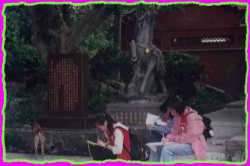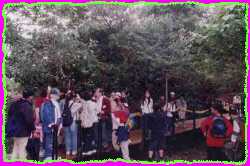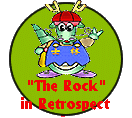
The 2001 World Cyberfair
"The Rock" -- in Retrospect
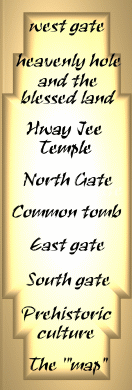
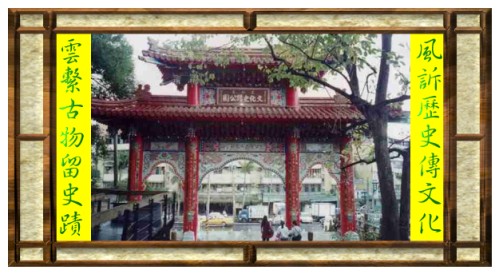
related info on our research project
-
the time our project plan was finished:12/20/00
-
school: Shih Lin Elementary School
-
Area: Shih Lin County, Taipei City
-
Directors:Ms.Tung Su Fen, Mr.Hsu Chin Fu, Ms.Hsu Mei Fang
-
number of students:21
-
their age:about 12
-
project's e-mail address:sjf921@ms19.hinet.net
overview of project
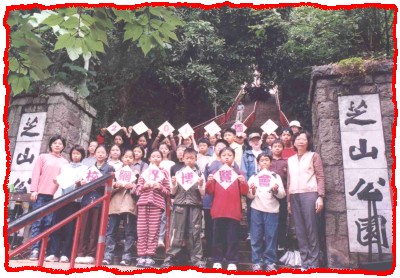
1. project category:Historical
landmarks
2.our definition of "local community":
「Community」is an important concept of modern society, and the point from which a country develops itself. It is the best type of natural classroom and serves as a mirror from which we can see how history shaped itself and how our future is likely to become.
Chee
Shan Rock ( the "Rock") is literally the fountainhead of modern
education in Taiwan; and Shih Lin Elementary School is
literally the very first school in this area. Thus, it
gives us special honor and special pride to explore this place and also
special responsibility to introduce to the world and share with everyone our
findings.
3. research project summary:
Our goal, from the outset, has been to make this research as fulfilling and creative as we possibly can, while involving "everyone"; also, due to the fact that the "Rock" is an essential part of our school's "community learning course", we carefully designed the project as to let students get a piece of the action, even if they were not on the website team. This included the Internet Mascot selection, drawing competition.
"The Rock" is a complete learning experience combining both sense and sensibility. For the students' learning purposes, we held such activities as data research, information analysis, first-hand photography, first-hand filming, first-hand interviews, computer drawing competitions, webpage designing, etc... all with pre-activity discussions and post-activity conferences. It is our hope that students will learn how to use valuable information that they gained "on their own" and transform that knowledge into a structure that he or she can utilize later in life; also, they should be able to develop a keen perception on the environment around them, because they were trained to observe in much more detail than they normally would.
When the
activities have come to a small finish, all the students would divide into
different groups, each handling a specific task, such as typing, data
analysis, artistic design, and computer software applications. In
addition, in order to "pass on the torch" and let others learn what
we've learned from this experience, we even designed
a "quizzes"
section.
4.our internet environment
Our school has ADSL networking using virtual IP with two NT servers and one NT workstation; the workstation is responsible for being the "firewall" and the servers are mail servers and run things like proxy, www,and DNS.
5.obstacles that we overcame
Much work has been done previously on this topic, so it wasn't hard to find related information, but they do look very similar. Thus we divided into groups and collected data, and analyzed them, following which we sought the help of Mr.Jiang of the cultural bureau plus several local elders who were kind enough to share with us their precious memories of the place.
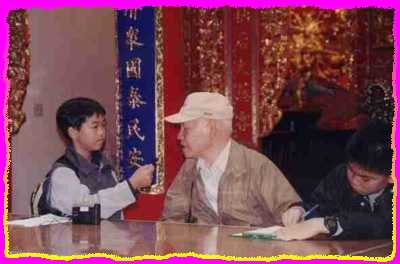
(1). even though during the interviews the elders spoke mainland accented Chinese which is tough to understand, but we recorded them down and listened to them repeatedly afterwards.
(2). Mr.Hsu taught the computer group about artwork every Tuesday and Thursday, but due to some of the difficulties, we sought the help of TKU Information Center's Ms.Chou.
(3). the information group worked especially hard to complete their task, sacrificing almost every holiday to finish up.
6.thoughts:
Nature is, for lack of a better word, the best teacher.
key elements of the project:
1. How does the research project benefit your
teaching and course requirement?
Dr. Vygotsky believed that learning is "the product after the learned interacted with society". His famous theory states that it is critical that the learner learn through cooperation and also learn with a specific and attainable goal in mind.
"The Rock" is what we call a theme-based learning model, or it can also be viewed as a "explore, cooperate, and learn" type of learning. There are no "forceful entry" of actual knowledge, but requires many experienced teachers and guides to help construct and develop the knowledge structure for the students.
This project is also an excellent example where all disciplines of learning were cleverly combined in one:
social studies and computer science:
(1). combining with computer information course---the Mascot selection successfully aroused the learning interests of thir to six graders of our school when the internet votes were open to the public.
(2). combining with art course----we held drawing competitions and scanned the works into our drawings webpage, and the students also learned photography.
3). combining with local culture learning----the beautiful and vast natural scenery and sights throughout "the Rock" provide students with excellent opportunities to see for themselves what words on textbooks really mean in actual life.
(4). historic analysis----develops students' ability to independently do research and present what they learned.
a. data collection and analysis
b. interviews with the elderly-they learned the art of learning from the learned
c. interviews with the tourists --they learned the art of learning from the common
d. qualitative analysis
the project fully helps students appreciate the concept of teamwork, and we also took advantage of utilizing community resources:
(1).Human resources-this includes people who were willing to share their precious life experiences with us, like the elders, photographers, guides, teachers, and even local tourists.
(2).natural resources-all the artifacts, sights, and facilities provided us with much insight into the matter.
(3).organization resources-the city government, the public library, the different business and social organization were all extremely helpful.
(4).material resources--students' families provided transportation, funds, and other necessary means.
In short, this is a complete cognition-oriented learning model:in order to use resources, student must learn to communicate; to find data, they must learn to use the library and computer to download information, and they need to learn to categorize, and set up cameras to achieve optimal visual results, and to design webpages, they must learn to draw maps on site, and to conduct interviews, they must learn to speak courteously and politely, and use recording devices, to respect others' intellectual property rights, they learned to reference every information, and finally to use all types of computer software, because ultimately it's a website competition!
|
|
|
2. What information technologies did you use to
complete your research project?
Because of the parents' care for their children, we found that every participant had basic computer equipments in their family. Thus in our first official tour, we've had students carry around digital cameras, recording devices, and v8 cameras to capture the entire event. A week later, we've got the very first printout from color printers done by the students themselves.
All the photographs in the webpage were first scanned into the computer using a scanner, and then edited using various softwares such as photoimpact, and digital computer drawings, and one of the most interesting characteristics of our website is the use of "actual drawing" done by our students, which gives an unique natural and passionate feel.
Telephones were basic tools. Then we used the library to find related books and newspapers. The internetwas our most important source of information, notes were the basic way of jotting down data, oral interviews and computer software such as FrontPage and CuteFTP provided addition assistance for us.
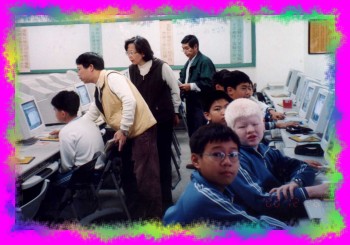
3.How did you play the role of spokesperson for your research project?
All students learned how to use e-mails, and they all had their own addresses and personal webpages via www.kimo.com.tw.
In the beginning, they learned how to do research over the internet, and raised questions and sought additional information in the Shih Lin Public Library, during the course of which would come in contact with different people in society, such as librarians, tourists, guides, scholars, and many others. Especially when the media released the news on December 7th about the two skeletons that were discovered in Chee Shan Rock, all of a sudden, not only did the internet community started taking note of this issue, even other students' parents were eager to get involved because of the importance of this project.
We
believe that when the website is finished, we can take the community along
for a travel back in time, and appreciate as much as we did the marvelous
cultural treasure that our ancestors have left for us.
4. What impact did this project have on you?
Because of the nature of the topic this time, the entire school and community simply went crazy because it was something they've known most of their lives; so all of a sudden there's the "rock fever" and computer learning became the "trendy" thing to do for students.
What was most touching is that parents continually provided us with information and precious clippings from the past; people even went as far as calling and inviting elders for us to interview, just so that our project could be even more complete and real and genuine.
As we go out to the
Rock more and more times, we are constantly reminded of how precious this
treasure is, and how fragile it is at the same time. We wanted so much
for our next generation to understand that the torch must be passed on to
them one day, and that what we do today affects directly what comes back to
us tomorrow. Civilization moves quickly, so cultural
preservation must keep up.
5. How did your community help with the project?
The nature of the research demands historic accuracy and careful data analysis. Thus with the kind and generous help of the following place we were able to find valuable information on the topic.City Government Cultural Bureau, cultural references committee, Yu Nong Elementary Schooland our centennial yearbook.
We wanted to make something modern of these 4,000 year-old information, thus we invited Mr.Yang of the Chinese Business Association , and Mr.Tung for discussing web design, Ms.Hsu felt that we ought to seek artistic help from the information center of TKU.
Special
thanks should be given to Mr.Shee, our
living dictionary and legend of the community who answered many of our
questions; Mr.Choualso gave us much
direction in art; photographer Mr.Wangalso
gave much help; during the four month period, students' parents even
organized their own parents' association to help
with funds and transportation; Principal Chang
and Director Goowere also quite
supportive of the entire project. We can say with confidence that the
teamwork and community effort that was put into this research project is
simply magnificent and impressive.
6. findings, surprises, and lessons
Although we set out to do a historic research, we were shocked to discover how much more knowledge such as plantlife, geology, archeology, and history that we needed to be familiar with to make the research more comprehensive.
One can never talk about snakefrog stone, or yellow-leaf phenomenon, or beehive walls without such background knowledge. And thus this is a project that can be passed on for generations to come to really "complete" it.
This conclusion is immediately backed up by the news event on December 7th, when two well-preserved skeletons were found right there at Chee Shan Rock. The skeletons were dated 2,500 to 3,000 years ago by City Government officials and archeologist Dr.Liu. This incident shows that we made a wonderful decision to study this place, because it turned out that The Rock is actually the beginning of civilization on Taiwan ( the earliest man found here ); in addition, it was also the fountainhead of education on this island, making the research project even more meaning.
In conclusion, we have not stopped being surprised by the tremendous support by the parents and the community, and we were often times shocked by the amount of talent and knowledge that lies within the parents of this school and an elderly of this community. We are both grateful and humble to take on the task of passing on our Shih Lin tradition -- the tradition of learning through doing, and always keep your hands tight with one another.
![]()

![]()
![]()
![]()

![]()
